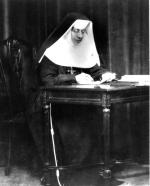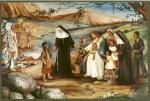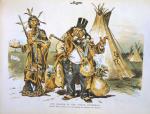![header=[Marker Text] body=[Wealthy socialite Katharine Drexel's travels in the northwest exposed her to the plight of Native Americans on reservations. To help alleviate their suffering and that of the oppressed among the Black people, in 1891 she established the Sisters of the Blessed Sacrament to educate Native American and African American students. Holy Providence High School at Bensalem was among her earliest missions.] sign](http://explorepahistory.com/kora/files/1/10/1-A-22E-139-ExplorePAHistory-a0h5e4-a_450.jpg)
Mouse over for marker text
Name:
Katharine Drexel (1858-1955)
Region:
Philadelphia and its Countryside/Lehigh Valley
County:
Bucks
Behind the Marker
Like many daughters born into wealthy nineteenth-century American families, Katharine Drexel was raised in luxury but witnessed poverty all around her. Her parents cultivated a sense of altruism in her from an early age, encouraging Katharine to participate in their own charity work. But even that upbringing did not prepare her for the wrenching human misery she encountered when she visited Indian reservations in the American West.
The native peoples living there had their way of life destroyed by an onslaught of soldiers, miners, railroad workers, and settlers. With no more buffalo to hunt and federal troops confining them to barren reservations, their numbers dwindled from disease, malnutrition, and social breakdown. They appeared to be a forgotten people, pushed aside by a modern industrial society anxious to exploit the land and resources that had once been theirs.
Drexel's experience on those reservations convinced her to devote her considerable fortune to the social welfare of America's disenfranchised peoples, and over the course of her lifetime she established more than sixty-five schools, missions, and churches for Native Americans and African-Americans in the American West and South for that purpose.
After working as a fund raiser and lay missionary among Indians and blacks as a young woman, Drexel entered a convent in 1889 and took religious vows, proclaiming her desire to be "the mother and servant of the Indian and Negro races." As a nun, she founded the Sisters of the Blessed Sacrament, an order dedicated to prayerful veneration of the Eucharist and the social welfare of the poor.
While her decisions and actions were personal, Drexel was also part of a much wider wave of social reform that swept the United States in the late 1800s. As the American economy industrialized and urban populations grew, philanthropists became concerned about the people modern America appeared to be leaving behind.
Drexel's mission among western Indians shared goals very similar to those of Richard Henry Pratt, the founder of the Carlisle Indian School. She wanted to ensure the Indians' assimilation into mainstream American society by converting them to Christianity and educating them in white customs of dress, diet, and discipline. She focused her efforts on children because they had the greatest potential for being indoctrinated in the beliefs, customs, and habits that defined white notions of "civilized society" in this period.
Carlisle Indian School. She wanted to ensure the Indians' assimilation into mainstream American society by converting them to Christianity and educating them in white customs of dress, diet, and discipline. She focused her efforts on children because they had the greatest potential for being indoctrinated in the beliefs, customs, and habits that defined white notions of "civilized society" in this period.
Drexel, however, did not embrace all of Pratt's methods. While Pratt insisted that Indian education would work only if the children were removed to boarding schools hundreds of miles away from their reservation homes, Drexel established a variety of boarding and day schools on reservations, where children could remain connected to family, friends, and community. Not surprisingly, Indian parents and children much preferred such reservation schools to the distant boarding schools established on Pratt's model.
Drexel's efforts in Indian and African American education were hindered by a tide of anti-Catholic prejudice in late nineteenth-century America. American Protestants resented the influx of Catholic Italian, Irish, and Polish immigrants and feared that their political and cultural influence was growing too great in American society. Responding to such prejudices, the federal government ended its funding for Catholic mission schools on Indian reservations, leaving them to fend for themselves in terms of recruiting students and financial support.
Despite this setback, Drexel and the Sisters of the Blessed Sacrament carried on their mission work during the twentieth century. The Catholic Church had a long history of missionary work among Native Americans, many of whom developed strong intergenerational ties with Catholic missionaries because of the missionaries' willingness to learn Indian languages and live in Indian communities.
After suffering a debilitating heart attack in 1935, Katharine Drexel retired from her ministry and spent the remaining years of her life in retirement. In October 2000, she was canonized by Pope John Paul II as a saint in the Roman Catholic Church, and the Sisters of the Blessed Sacrament remain active in their social mission today from their headquarters in Bensalem, Pennsylvania.
The native peoples living there had their way of life destroyed by an onslaught of soldiers, miners, railroad workers, and settlers. With no more buffalo to hunt and federal troops confining them to barren reservations, their numbers dwindled from disease, malnutrition, and social breakdown. They appeared to be a forgotten people, pushed aside by a modern industrial society anxious to exploit the land and resources that had once been theirs.
Drexel's experience on those reservations convinced her to devote her considerable fortune to the social welfare of America's disenfranchised peoples, and over the course of her lifetime she established more than sixty-five schools, missions, and churches for Native Americans and African-Americans in the American West and South for that purpose.
After working as a fund raiser and lay missionary among Indians and blacks as a young woman, Drexel entered a convent in 1889 and took religious vows, proclaiming her desire to be "the mother and servant of the Indian and Negro races." As a nun, she founded the Sisters of the Blessed Sacrament, an order dedicated to prayerful veneration of the Eucharist and the social welfare of the poor.
While her decisions and actions were personal, Drexel was also part of a much wider wave of social reform that swept the United States in the late 1800s. As the American economy industrialized and urban populations grew, philanthropists became concerned about the people modern America appeared to be leaving behind.
Drexel's mission among western Indians shared goals very similar to those of Richard Henry Pratt, the founder of the
Drexel, however, did not embrace all of Pratt's methods. While Pratt insisted that Indian education would work only if the children were removed to boarding schools hundreds of miles away from their reservation homes, Drexel established a variety of boarding and day schools on reservations, where children could remain connected to family, friends, and community. Not surprisingly, Indian parents and children much preferred such reservation schools to the distant boarding schools established on Pratt's model.
Drexel's efforts in Indian and African American education were hindered by a tide of anti-Catholic prejudice in late nineteenth-century America. American Protestants resented the influx of Catholic Italian, Irish, and Polish immigrants and feared that their political and cultural influence was growing too great in American society. Responding to such prejudices, the federal government ended its funding for Catholic mission schools on Indian reservations, leaving them to fend for themselves in terms of recruiting students and financial support.
Despite this setback, Drexel and the Sisters of the Blessed Sacrament carried on their mission work during the twentieth century. The Catholic Church had a long history of missionary work among Native Americans, many of whom developed strong intergenerational ties with Catholic missionaries because of the missionaries' willingness to learn Indian languages and live in Indian communities.
After suffering a debilitating heart attack in 1935, Katharine Drexel retired from her ministry and spent the remaining years of her life in retirement. In October 2000, she was canonized by Pope John Paul II as a saint in the Roman Catholic Church, and the Sisters of the Blessed Sacrament remain active in their social mission today from their headquarters in Bensalem, Pennsylvania.








